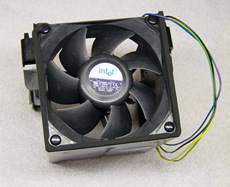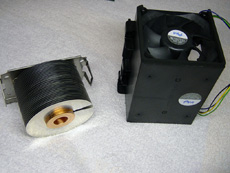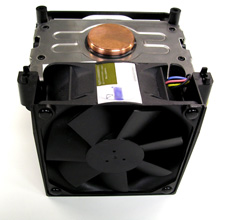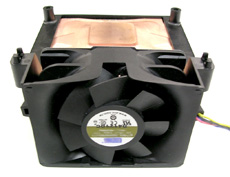Intel's Long Awaited BTX Form Factor
by Purav Sanghani on November 15, 2004 5:31 AM EST- Posted in
- Cases/Cooling/PSUs
BTX Cooling and Airflow
Again, the main reasoning behind Intel during the redesign of the ATX form factor was to design a more efficient cooling solution. As components are built faster they also run hotter. The ATX form factor improved on the AT specifications by placing the CPU closer to the back of the case where fans could be mounted as exhausts to pull hot air from the CPU out of the chassis and away from other components. Now that those other components in PCs are beginning to expand in performance and functionality they are running at temperatures as high as that of CPUs so a new design needed to be devised to help cool these components in a more efficient manner than just slapping more fans in a standard case. Now, we have come full circle with the CPU moving back towards the front of the case. Since Intel has the standards on PCIe very heavily controlled, worrying about PCIe cards extending too far to the front of the case should not be a problem.Intel implements a more efficient passive cooling system by placing the majority of components inline with the CPU towards the rear of the chasis.
 Click to Enlarge |
 Click to Enlarge |
The most important piece of hardware when it comes to cooling is the CPU heat sink fan. Without this a CPU would not POST, and would most likely damage the hardware. Intel has included what it calls a "BTX Thermal Module" which consist of either a spiral or stacked-fin heatsink and a fan which is mounted at the end of a plastic duct, facing the front end of the case. Intel has not limited this hardware to only one type though. In their virtual press kit Intel speaks of Type I (Standard height) and Type II (Low profile) thermal modules. The Type I module will be designed for a broader range of cases from small form factor to the larger full tower applications while the Type II module will be designed specifically for the ultra-small form factor designs.
 Click to Enlarge |
 Click to Enlarge |
Intel also mentioned that along with those two types of thermal modules there will be variations in the units for processors rated at different Thermal Design Power, or TDP levels. The difference in modules will exist mainly with the heatsink, with slight variations in the duct. The fan will, however, remain the same within the same type (Type I/Type II) of module.
This thermal module was the only piece of cooling hardware aside from the power supply which we found to be surprising. We couldn't imagine running an ATX case with only one CPU heatsink fan and we have our doubts about Intel's single module design, but we will leave that to our benchmarks to decide.










77 Comments
View All Comments
DerekBaker - Monday, November 15, 2004 - link
#25From here I should think: ">From the picture we see the flow of warm air pulled forward from beyond the VGA card. As it moves towards the front of the case the air flows over the Southbridge and Northbridge passively cooling each chip. We then see from the shades of red the air warms up as it flows through the CPU heatsink then begins to cool as it moves out the front of the case."
http://www.anandtech.com/casecooling/showdoc.aspx?...
Derek
Oxonium - Monday, November 15, 2004 - link
Let's see, a new form factor with new case requirements and STILL no standardized connector for the front Power/Reset/LED's/etc.? I'm all for cooler cases, but a standardized connector for those items is something that should have been implemented years ago.HardwareD00d - Monday, November 15, 2004 - link
#24, who cares since athlons run much cooler and don't need this case form factor.Doormat - Monday, November 15, 2004 - link
I heard a rumor that it wont work with Athlon 64 chips or any type of chip that has the memory controller integrated with the processor, because the distance between the processor and the RAM banks are too far. Anyone confirm this?Superbike - Monday, November 15, 2004 - link
Wow AT is back.phisrow - Monday, November 15, 2004 - link
While I agree that the tweaky enthusiast market doesn't have much to gain at the moment by moving from ATX to BTX, especially as most of them are running A64s or praying-for-death overclocked mobile Athlons, I think there is certainly something to be said for the form-factor. It does seem to be more efficient for cooling than your average ATX(especially for small cases). Even if you are running some PentiumM or a derivative thereof, more efficient is still better. After all, if a given case design can cool a high-end Prescott without deafening its user, it can probably cool a brutally overclocked Pentium M with its fans running at half the speed. For that matter, if the trace length issues aren't actually crippling, I would like to see some A64 motherboards in this format.johnsonx - Monday, November 15, 2004 - link
Visualize an office full of MicroBTX Desktop computers. Visualize the women in the office cupping their hands around the heat exhaust... visualize the overclocking tips flowing around the female staff as they strive to increase heat output... visualize the men pouring sweat, desparately trying to duct-tape the front vent to block the hot Intel Air.I'm sorry, but any spec that seeks to exhaust hot air out the FRONT of any case, whether it be a desktop, tower or SFF, is just plain STUPID.
araczynski - Monday, November 15, 2004 - link
my god, after all these years, they fall back on the packard bell mentality...KristopherKubicki - Monday, November 15, 2004 - link
GTMan: Temperatures were certainly taken with the cases closed.Kristopher
GTMan - Monday, November 15, 2004 - link
I wonder if all those temperature measurements were done with the case open? I would think a case designed for efficient air flow would only perform properly (as designed) when fully assembled!!!